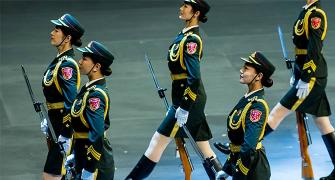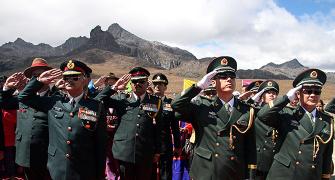
The state-run Chinese media has hailed the recent friendly exchange between Indian Defence Minister Nirmala Sitharaman and the Chinese troops at the Sino-Indian border in Nathu-la on Saturday, terming it as the most ‘warm-hearted scene’ ever since a truce was called on the Doklam stand-off.
The Global Times, in an editorial, titled ‘Sitharaman greeting sends warm signal’, said that the Indian defence minister’s traditional ‘namaste’ greetings to the Chinese soldiers conveyed her hope for peace along the border and “unwillingness to see a new stand-off,” adding that this was an attitude of Prime Minister Narendra Modi’s government at the Centre.
“Sitharaman’s greeting to the Chinese soldiers conveys her hope for peace on the Sino-Indian border and unwillingness to see a new stand-off. This is commonly regarded as the attitude of the Narendra Modi government,” it said.
“This is a realistic and responsible attitude for the country and its people. Both before and after the Doklam crisis, the Chinese government hopes for border peace with the broad support of the Chinese people. But Indian society’s understanding of their country’s border policy seems ambiguous and chaotic. Some Indians believe New Delhi will take tough measures to crush Beijing’s will,” it added.
The light-hearted exchange saw Sitharaman greeting the Chinese soldiers ‘namaste’, to which they responded with ‘Ni Hao’.
The two sides also discussed the meaning of their respective form of greetings.
“An Indian soldier standing beside Sitharaman is seen holding a gift in the video released by the Indian defence ministry, probably the most warm-hearted scene since the Doklam standoff,” the Chinese daily said.
However, the daily also saw Sitharaman’s visit to the border regions as New Delhi’s push to intensify combat readiness against Beijing.
“But Sitharaman’s traditional ‘Namaste’ greetings to the Chinese soldiers sent another signal to the public that might not erase the first impression, but may at least balance things out,” it added.
The editorial further said, “Being on guard against China is a widespread mindset in the Indian society. But confrontation with Beijing is also a radical idea beyond its national strength and contradicts its fundamental interests. Such an idea is only advocated by extreme nationalists. Indian public opinion is inquisitorial on any hard-line Beijing policy by the Indian government and foresees a “second round of Sino-
Indian face-offs, constantly pressuring New Delhi’s diplomacy after the Doklam stand-off,” the daily said.
The daily also noted that New Delhi has been strengthening its military presence at the Sino-Indian border in recent years. The Gobal Times said that China welcomed Sitharaman’s greeting and hoped the gesture is also welcomed by Indians and added that her charm might help break the ice between Chinese and Indian public opinion.
“India isn’t a major focus for China’s international strategy. India’s development lags behind China. Its modernisation and development does not depend on winning the initiative in its relations with China. Friendly cooperation is the best option, strategic exhaustion the worst. Both countries should control the risks,” the daily opined.
“Indians must overcome the paranoia that suggests their country is strategically thwarted and threatened by Beijing. New Delhi also needs to give up its pursuit of Washington and Tokyo support to deploy as a bargaining chip against Beijing. As India gradually rises to become a major economy, being more diplomatically independent is a must. Confrontation with China will directly limit its international strategic space,” it further said.
The Indian Army and the China’s People’s Liberation Army had, on August 28, decided to disengage their troops from Bhutan’s Doklam plateau after months-long stand-off.
Tensions rose between the two countries when China began constructing a road in the Doklam plateau region at the Sikkim-Bhutan-Tibet tri-junction.











